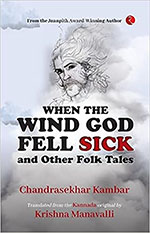Chandrasekhar Kambar, though recognized as one of the foremost Navya (modernist) writers in Kannada, along with the likes of UR Ananathamurthy, P Lankesh, Girish Karnad, Ramachandra Sharma, Shantinath Desai and KV Tirumalesh, was always different from them. While the others had read European literature of the day and were trying to define their style vis-à-vis their counterparts in Europe and blending it/bending it here to suit the needs of post-Independence India, Kambar created his own world/cosmos and named it Shivapura. Most of his writings, whether narrative pieces or even dramatic pieces, where he is involved in what other critics have identified as ‘myth making’, take place in this Shivapura. The present collection contains a play (which in turn is based on a ‘folk’ story) and six other stories which also take place in Shivapura, this imaginary village, which is the world/cosmos of the narratives of Kambar. It is in this imaginary space that the tradition-modernity, fertility-infertility, poverty-richness conflicts play out on the axis of urban-rural, caste and gender.
In this book, the translator Krishna Manavalli brings to us carefully chosen stories/plays of Kambar where the conflict is between the forest and city/village. The narrative style and tropes are modelled on folk stories, hence they are called folk tales. Here the human beings and other beings, flora and fauna, and natural elements like wind and rain jostle with each other. The god/s, ghosts are no exception to it. The tales are full of anthropomorphism. The stories fashion morality not just by defining human relations within a society, but by defining a cosmic morality where the relationship between living beings, imaginary entities and natural elements is explored, and an ideal relationship between these entities is projected at the end of the tale. The stories point at a harmonious co-existence of these entities, in spite of the antagonistic relationships that exist between them whether they are natural or social. It takes the ups and downs in the relation in its stride and exudes confidence through the narrative resolution that a balance, an equilibrium, could be achieved for the benefit of all. It focuses on the interrelatedness of these entities: the city/village cannot survive without the forest. The forest/forest produce find their goal being fulfilled by the human beings. It argues for a non-exploitative relation between these entities, one which is not marked by greed, but through mutual cooperation. There is not much difference between natural elements, mysterious old women/men, gods, ghosts/demons, nymphs; they all have their share of wrath, love, kindness, jealousy. Here, these folk-elements, folk-style narratives not just come as a metaphor to speak about the modern-human social issues, but narrate to us the need for a cosmic-morality, ethics of a non-anthropocentric world.
The play The Tale of the Flower Queen (Pushpa Rani in Kannada) has already proved to be a theatrical success in Kannada with umpteen number of productions/shows. It has 16 scenes and occupies nearly half of the collection. It is appropriate that this play is now available in English. Even the other tales, though not presented explicitly as plays, are highly dramatic and stage-worthy. The conversation is visually presented as dialogues in direct speech; of course, the other parts are in prose. They are meant not only to be read, narrated aloud to a group but worth enacting on stage.
The tales make the readers enter a magical world where the all elements of nature appear as characters and enter into conversations, exhibit all human emotions, get transformed as the plot unfolds to reveal to us an insight into nature. It enthrals the readers, holds their attention till the end, and, that is the magic of weaving of these stories by Kambar.
The principle of selection of the translated collection is clearly stated in the ‘Translator’s Note’, as ‘ecological ideals’ (p. xiii). The note by the translator Krishna Manavalli, who has established herself in the last decade as one of the leading translators of Chandrasekhar Kambar’s works into English, talks about not just translating the text, but also the reader. She clearly states that while trying to prepare global readers to enter this world of Kannada, she has to tread a fine balance between making it readable and also locating it in a culture and context which gave rise to it. For this purpose, she has foot-notes to explain the context/culture. But they are very few and do not come in the way of the experience of the cosmic folk-world for the readers. The intended readers are those belonging to the younger generation, who are into the world of the smart-phone. If this generation can pick up this book, I am sure they would partake of this cosmic conversation and immerse themselves in this cosmic morality.
The book also has an introduction by the author where Kambar clearly specifies that he doesn’t write for the ‘academic and highbrow intellectual circles’ (p. ix). He clearly marks these tales as writings for children in his introduction. The issues of environment and the ecological perspective are gaining credentials in academics; the collection focuses on those stories which address the issues of ecology. Thus, I would argue that these stories are meant not only for the smart-phone savvy generation, but also for grown-ups; they provide a perspective which academia is looking for in the context of non-anthropocentric and environmental perspective of literature.
You cannot put down the book once you start reading it; it urges you to go on. But the sad part of it is that it ends within a little over hundred pages. One is left with a feeling of wanting more.
November 2023, volume 47, No 11

